
How to Clean Outdoor Furniture: Maintenance and Care Tips for Every Material
Outdoor furniture is built tough but still needs care. Follow these cleaning and protection tips to keep your patio sets beautiful season after season.
By:
The Good Home Daily
Posted on October 10, 2025
Outdoor furniture is built tough, designed to withstand sun, rain, and daily use.
In the Philippines, more homeowners are investing in outdoor furniture to enhance their patios and gardens. When you spend on pieces that are meant to last, you naturally want them to stay in top condition.
That is why outdoor furniture care is important. Even durable materials can fade, rust, or wear over time if neglected. Regular cleaning and thoughtful outdoor furniture maintenance help your investment stay beautiful and functional for years.
In this guide, we’ll show you how to clean your outdoor furniture by material. You’ll also learn how to protect outdoor furniture to extend its lifespan.
How to Clean Wicker Patio Furniture
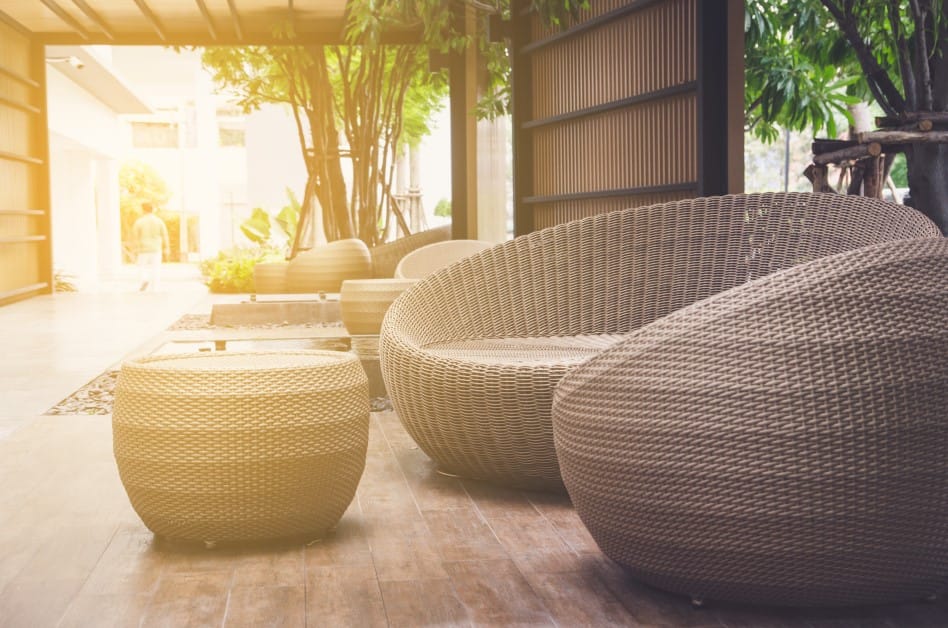
Wicker furniture, whether natural or synthetic resin, offers a beautiful texture to your patio. Its woven design, however, can easily trap dirt, dust, and debris. With a regular cleaning routine, you can keep it looking fresh and sturdy for years.
Here are the steps for cleaning wicker patio furniture:
- Use a soft brush or a vacuum with a brush attachment to remove dust and loose dirt.
- Use a gentle solution to wash your furniture. Wicker is delicate, and harsh chemicals can damage its finish (especially natural wicker). We recommend mixing mild soap with warm water instead of strong chemicals.
- Dip a soft cloth or sponge in the solution and wipe the wicker surfaces. Avoid soaking the furniture since too much water can loosen natural fibers.
- If needed, lightly rinse with clean water, but make sure to dry it thoroughly. Place the furniture in a shaded, well-ventilated area to prevent warping.
- Natural wicker is more delicate than synthetic types. Apply a thin coat of furniture wax once or twice a year to maintain flexibility and shine.
How to Clean Your Wood Outdoor Furniture
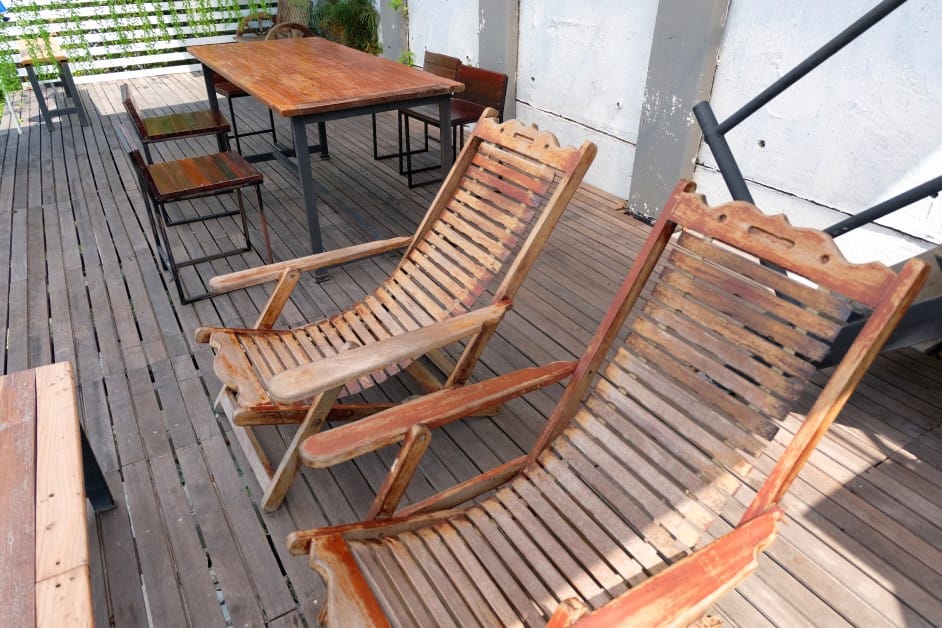
Wooden furniture brings warmth and timeless appeal to any outdoor space. But because wood is a natural material, it requires consistent care to stay strong and beautiful.
Wood is a durable material; however, its strength doesn’t protect it from everything. In fact, even the most durable wooden furniture can be sun faded. Be careful, as some cleaning mistakes can lead to warping, cracking, or discoloration over time.
Here are the proper steps you can follow:
- Start by wiping away dust, pollen, or leaves using a soft brush or dry cloth. This prevents dirt from settling into the wood grain.
- Mix a mild cleaning solution using warm water and a small amount of mild dish soap or an approved wood cleaner.
- Using a soft cloth or a sponge, wipe down the furniture, working in the direction of the wood grain. For tougher spots (like bird droppings or tree sap), use a soft-bristle brush, scrubbing gently.
- Use clean water to wash off the soap. Make sure no residue is left behind since it can dull the finish over time. Avoid pressure washers, as the high pressure can damage the wood fibers and grain.
- Allow the furniture to air dry completely before applying any sealants or oils.
How to Clean Outdoor Cushions and Fabrics
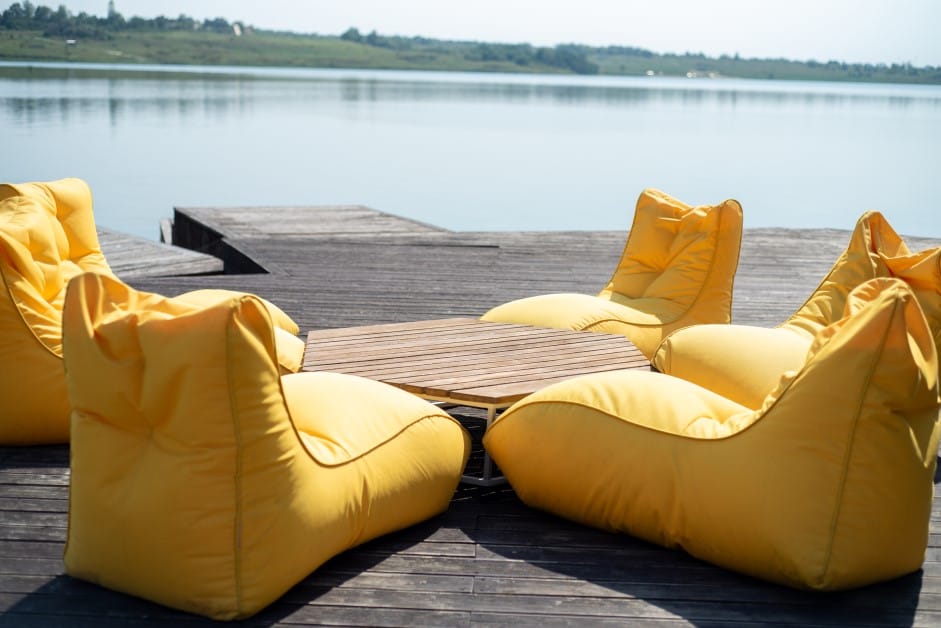
Fabrics and cushions are among the most vulnerable materials to mildew and staining. They collect dust, spills, and even mildew over time.
Unlike harder surfaces, fabrics and cushions also need extra care when cleaning. Using the wrong products or harsh scrubbing can damage the material and shorten its lifespan. Here are the steps you can take to clean them properly:
- Remove loose dirt by shaking the cushions or gently brushing with a soft-bristled brush.
- Use a handheld vacuum or an upholstery attachment to get rid of deeper dust and debris lodged in seams and creases.
- Mix mild soap with warm water and use a clean sponge or cloth to blot stains. Avoid scrubbing too hard as it can damage the fabric.
- For removable covers, check the care label. Most can be machine-washed on a gentle cycle with mild detergent. For non-removable covers, scrub lightly with soapy water, rinse well, and let air dry.
- Always let cushions and fabrics dry in a well-ventilated space under the sun. Make sure they’re fully dry before placing them back to prevent mold and mildew.
How to Clean Metal Furniture

Metal outdoor furniture is known for its strength and timeless appeal. Whether it is made from aluminum, steel, or wrought iron, it can withstand heavy use and harsh weather. But without proper care, even the toughest metal patio furniture may develop rust, stains, or a dull finish over time.
Here’s how to properly clean your metal furniture:
- Use a soft cloth or brush to remove dirt, dust, and cobwebs. This prevents buildup that can scratch the surface during cleaning.
- Mix warm water with a small amount of mild dish soap. Dip a sponge or cloth into the solution and gently scrub the surface of your metal furniture. Avoid harsh cleaners that may damage protective coatings.
- Wipe away soap residue with clean water. Leftover soap can attract more dirt and leave streaks.
Moisture is the biggest enemy of metal outdoor furniture. Towel-dry and let the pieces air dry under the sun, paying extra attention to corners and joints. - If you notice rust, sand the affected area gently with fine-grit sandpaper or apply a rust remover. After cleaning, touch up with rust-resistant paint or primer.
- Apply a clear sealant or car wax to your metal patio furniture. This adds shine, prevents water spots, and slows down rust formation.
How to Clean Your Plastic Outdoor Furniture
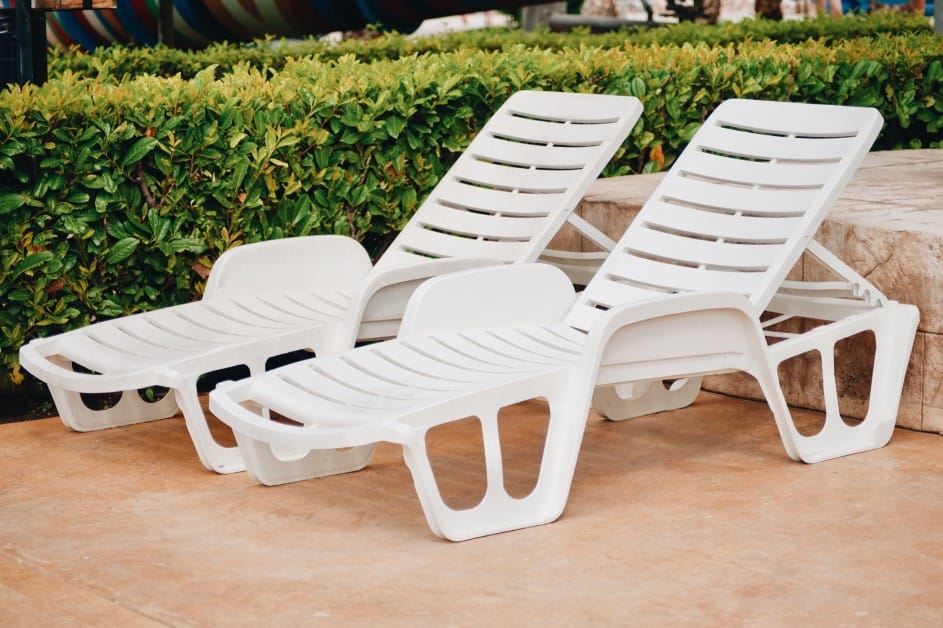
Plastic outdoor furniture is loved for being lightweight, affordable, and easy to move around. However, it is also prone to stains, discoloration, and a chalky finish from constant sun exposure. With proper cleaning, you can keep your plastic patio furniture looking bright and fresh for years.
Here’s how to properly clean your plastic outdoor furniture:
- Wipe down your plastic furniture with a dry cloth or soft brush to remove dust and debris.
- Mix warm water with mild dish soap. Use a sponge or soft cloth to scrub the surfaces, paying attention to corners and textured areas.
- For tough spots, make a paste of baking soda and water, then gently rub it onto the stain. Avoid abrasive scrubbers that may scratch the plastic.
- Hose down or wipe the furniture with clean water to remove all soap and residue.
- Allow your plastic outdoor furniture to air dry in the sun or wipe it down with a towel to prevent water spots.
5 Common Mistakes in Cleaning Outdoor Furniture
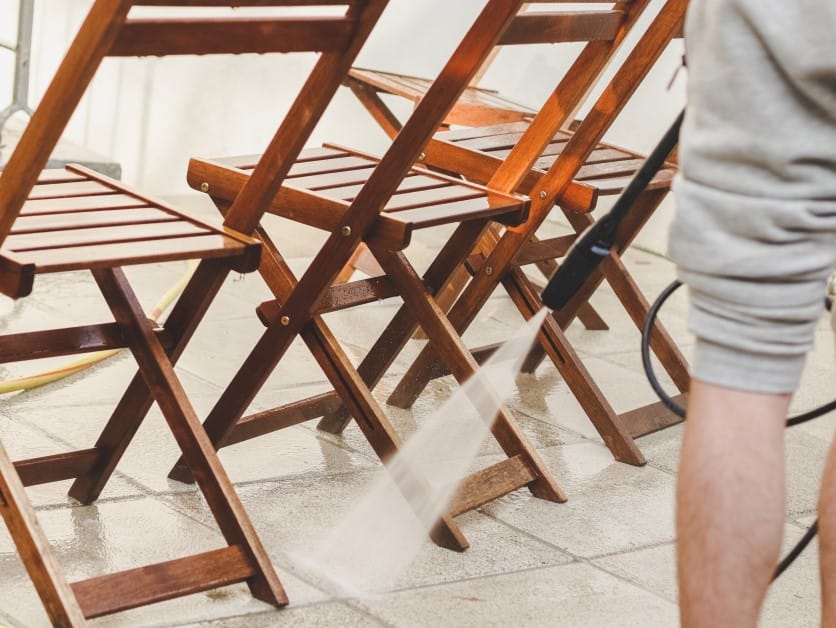
Even with the best intentions, some cleaning habits can do more harm than good to your outdoor furniture. To help you avoid costly mistakes, avoid doing these when cleaning your patio furniture:
1. Using Bleach or Harsh Chemicals on Fabrics
Bleach may seem like a quick stain remover, but it can strip color, weaken fibers, and damage coatings. A study on household bleach also confirmed that it causes significant fading on colored fabrics. Use mild detergent or fabric-safe cleaners instead.
2. Using a Pressure Washer on Delicate Materials
Using high-pressure water allows you to clean faster, but it can also damage your furniture. It can strip paint, damage wicker, and force moisture into joints, which can lead to mold and mildew.
Do not use a pressure washer on high settings, especially with a narrow nozzle, on soft materials like wicker, rattan, softwoods, and cushions. Stick to a gentle hose spray or soft sponge for safer cleaning.
3. Leaving Cleaning Product Residue
When detergent or cleaning chemicals are not completely rinsed off, residues can attract more dirt, degrade finishes, or cause streaking or discoloration. Always rinse thoroughly with clean water to prevent streaks and buildup.
4. Over-Wetting Wooden Furniture
Never use a soaked rag or allow water to pool or sit on the surface of wooden furniture. Always clean with a damp (not dripping) cloth and ensure the surface is dried quickly and thoroughly afterward.
Since wood is porous, it quickly absorbs moisture. When wood fibers absorb water, they swell. When they dry, they shrink. Over time, this uneven swelling and shrinking can result in warping, cracking, splitting, or even joint failure.
Wood science research also shows that decay fungi become active when moisture content (MC) exceeds the fiber saturation point around 28%–30%. To prevent decay, experts recommend keeping wood moisture content below 20%. This is why drying your wood patio furniture after every cleaning is crucial.
5. Using an Abrasive Cleaner or Tool
Avoid scouring pads, steel wool, highly abrasive powders, or hard-bristle wire brushes on surfaces like powder-coated metal, painted wood, or vinyl straps.
Scratches from stiff brushes, steel wool, or overly abrasive tools create micro-scratches that collect dirt, fade the finish, or weaken fibers. On wood, this degrades the protective coating. On fabrics, it can cause fraying.
We recommend using soft-bristle brushes, sponges, or microfiber cloths for cleaning outdoor furniture. For crevices, use soft tools like a toothbrush rather than wire brushes.
5 Tips for Protecting Outdoor Furniture
Cleaning is only half the job; the real secret to long-lasting outdoor furniture is regular maintenance and protection. Sun, rain, humidity, and dust can wear down even the toughest materials. With the right habits, you can protect outdoor furniture and keep it looking beautiful for years.
1. Use Protective Covers
Invest in durable, water-resistant, and UV-resistant covers. Look for covers that are also breathable to prevent moisture and condensation from building up underneath, which can lead to mold and mildew.
2. Apply Sealants and Treatments
Apply wood sealant, teak oil, or linseed oil at least once or twice a year. This adds a protective layer that guards against moisture and sun damage.
For metal pieces, protective coatings are essential. Anti-rust sprays or powder coatings create a shield against corrosion, especially if your furniture is exposed to rain or salty air near the coast. Without them, rust can spread quickly and weaken the structure.
Fabric cushions and upholstery also need extra care. Fabric protectors work by repelling water and stains, allowing spills to bead up instead of soaking in. This not only keeps them cleaner but also helps them dry faster.
3. Provide Shade
Position furniture under an awning, pergola, market umbrella, or covered patio. Doing this allows you to reduce direct exposure to harsh UV rays, which cause fading (discoloration) and material breakdown (cracking/drying).
4. Store Cushions
Cushions and pillows may be designed for outdoor use, but they are still vulnerable to moisture and mildew. Leaving them outside all the time shortens their lifespan.
Bring them indoors when not in use, especially during rainy days or the off-season. If indoor storage is not convenient, use a waterproof deck box or storage bench. It provides protection from the elements while keeping your outdoor space organized.
5. Keep Furniture Elevated
Avoid placing your outdoor furniture directly on soil or grass. Constant contact with moisture from the ground can lead to faster deterioration, especially for wood and metal pieces.
Using risers, rubber pads, or even a simple outdoor rug creates a barrier between your furniture and the damp ground. This small adjustment prevents water from seeping into wooden legs and stops rust from forming underneath metal frames.
Outdoor Furniture Also Deserves Tender Loving Care
As you throw open the doors to let the sunlight into your home and step outside, remember that your outdoor furniture is also constantly exposed to the elements. While it’s built to last, durability doesn’t mean you can forget about care.
Sun, rain, and everyday use will always leave their mark if your pieces are neglected.
By giving your chairs, cushions, and tables regular cleaning and simple maintenance, you protect your investment and keep your outdoor space inviting.
A little tender loving care goes a long way in making sure your patio, garden, or balcony remains a place of comfort and style for years to come.

